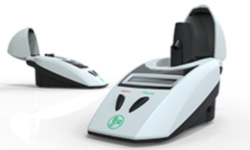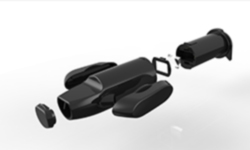- info@rapidbiosensor.com
- Tel +44 (0)1223 264558
- © 2020 Rapid Biosensor Systems
A TB BREATH TEST TO TACKLE A WORLDWIDE TB EPIDEMIC
You can read more below and the following link about this revolutionary TB Medical Device, it's application for TB Screening, it's technologies, licensing and future planned applications. But first some background information on the current situation concerncing tuberculosis:
The Rapid Biosensor TB Breathalyser

The Rapid Biosensor Systems TB Breathalyser is a non-invasive screening solution incorporating a range of technologies that allow for full portability and almost instant results with a simple breath test for TB. It can be assembled without the need for clean room conditions and may be used by non-medical personnel. As a result, the technology is particularly suitable for use in developing countries where low screening costs are a key factor to implementing suitable treatment programmes.
The TB Breathalyser has been developed by Rapid Biosensor Systems (RBS), a technology development company with extensive experience in medical diagnosis, optics, biochemistry and industrial design. Based in Cambridge, UK, RBS was founded in 2002 by Dr Elaine McCash, Dr Nicol Murray and Dennis Camilleri to exploit patented bio-optical technology and develop solutions for the rapid screening and diagnosis screening of infectious diseases in humans and animals. The six-year research and development programme that created the TB Breathalyser has been supported by grants from the WHO and the UK government and equity or loan investment of £1 million.
TB Screening and Diagnosis - The Current Situation
In recent years, a number of 'old' diseases have re-emerged as significant threats to world health, driven by factors such as population migration and modern transportation. Of particular concern is the increase in the incidence of tuberculosis (TB) infection, a highly contagious disease spread through the air when those who are infected cough, sneeze or spit. According to statistics published by World Health Organization (WHO), 8.8 million active cases of tuberculosis (TB) are diagnosed each year - 25,000 every day - and of these patients, almost 2 million die - approximately 5,000 every day. The majority of cases occur in the world's poorest countries, but no region is free from the threat - infection levels are rising in Western Europe, for example.
Whilst developing new and better medicines are vital to combating the TB epidemic, effective diagnosis enables health workers to quickly identify the correct course of treatment and so avoid wasting both time and valuable resources.
The first step towards effective diagnosis is rapid and accurate screening. Furthermore, given that TB is most prevalent in the poorest countries, such screening should ideally be low-cost and capable of administration by personnel with minimal training. Unfortunately, the Mantoux tuberculin skin test that is most widely used for screening meets none of these requirements. It involves a health worker injecting testing fluid (tuberculin) under the skin of the patient's arm, then waiting between 48 and 72 hours to see if there is a reaction - a red swelling on the injection site - that indicates the presence of TB. The diameter of the swelling indicates if the patient has been exposed to TB, but factors such as the patient's health and age have to be taken into account. This requirement for expert assessment introduces a degree of subjective interpretation to the test. Final results of the test can take as long as two weeks.
How the TB Breathalyser works:

The TB Breath Test is undertaken in an integrated system comprising a single-use disposable sample collection tube (measuring 10cm in length and 3.5cm in width) and a multi-use reader. After being nebulised using a 0.9% saline solution, the patient coughs into the collection tube, at the bottom of which is a glass bio-sensor coated with a patented bio-chemical coating formulated to react with the TB bacilli. A simple push-and-twist action automatically seals the aerosol sample in the tube and deposits it on the bio-sensor. The tube is then inserted into the reader and twisted to switch on the unit.
The TB Breathalyser analyses the patient's sample by performing a displacement assay employing evanescent wave technology, an established biochemical process that is proven and fast. The reader unit incorporates a diode laser that interrogates the bio-chemical coating carrying the sample. The coating contains analogues that are coated with a fluorescent material. In the displacement assay process, the TB antigen displaces fluorescently-coated analogues and bonds more strongly to antibodies, causing a reduction in the fluorescent signal after excitation by the laser. The laser detects this signal change and the unit returns a positive result. Reading and analysis of the sample takes approximately two minutes, and from start to finish, the entire screening process takes just a few minutes. After use, the sample tube is destroyed.
Advantages:
No other TB breath test currently available delivers such a rapid response at the point of care. The TB Breathalyser has very high specificity and sensitivity, in the most recent trials the sensitivity and specificity for actively infectious pulmonary TB were in excess of 95%. In comparison, the Mantoux tuberculin test has a specificity of 10% and a sensitivity of up to 85% (the WHO's guidelines for TB screening are 60% and up to 95% respectively), requires two visits by a health professional and can take up to two weeks before delivering results. Unlike the Mantoux test, the TB Breathalyser is not compromised by the presence of any other infective agents, so other respiratory tract conditions are discounted and only early stage TB and actively infectious TB will be recognised. Furthermore, the presence of HIV as a masking agent is ignored - an important consideration in the light of the co-existence of TB and HIV in the populations of many developing countries.
The breathalyser system uses aerosol collection (fine liquid droplets in a gas, in this case a cough), combined with an immunoassay system, with fluorescence detection of an evanescent wave. Key features are:
- Results correlate with X-ray, Sputum smear & clinical exam.
- Rapid Biosensor Systems test detects actively infectious TB bacilli 'free' to be coughed out.
- Results are unaffected by other conditions, HIV, URTI, cancer etc.
- Detects TB early stage infection before sputum smear/X-ray, with sensitivity and specificity of >95%+.
- Limit of detection estimated at ~ 25-75 bacilli.
- Fast, non-invasive & easy to use.
- Highly portable; mains electricity is not required so can be used in rural communities.
- Can diagnose patients who do not produce sputum (~50% of total).
Patented technology:
Rapid Biosensor Systems's state-of-the-art bio-optical technology is protected by comprehensive and robust international patents. You can read more about these patents here